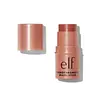What's inside
What's inside
 Key Ingredients
Key Ingredients

 Benefits
Benefits

No benefits
 Concerns
Concerns

 Ingredients Side-by-side
Ingredients Side-by-side

Silica
AbrasiveTriethylhexanoin
MaskingDimethicone
EmollientSynthetic Fluorphlogopite
Cetyl Ethylhexanoate
EmollientHydrogenated Polydecene
EmollientSynthetic Wax
AbrasiveIsononyl Isononanoate
EmollientMicrocrystalline Wax
Emulsion StabilisingEuphorbia Cerifera Cera
AstringentSorbitan Sesquiisostearate
EmulsifyingMica
Cosmetic ColorantPhenoxyethanol
PreservativeTocopheryl Acetate
AntioxidantTin Oxide
AbrasiveCI 77491
Cosmetic ColorantCI 77891
Cosmetic ColorantCI 19140
Cosmetic ColorantSilica, Triethylhexanoin, Dimethicone, Synthetic Fluorphlogopite, Cetyl Ethylhexanoate, Hydrogenated Polydecene, Synthetic Wax, Isononyl Isononanoate, Microcrystalline Wax, Euphorbia Cerifera Cera, Sorbitan Sesquiisostearate, Mica, Phenoxyethanol, Tocopheryl Acetate, Tin Oxide, CI 77491, CI 77891, CI 19140
Butylene Glycol Dicaprylate/Dicaprate
EmollientDimethicone
EmollientIsotridecyl Isononanoate
EmollientPolyglyceryl-2 Triisostearate
EmulsifyingPolymethylsilsesquioxane
Mica
Cosmetic ColorantSynthetic Fluorphlogopite
Silica
AbrasiveParaffin
PerfumingCalcium Aluminum Borosilicate
Polyethylene
AbrasiveMicrocrystalline Wax
Emulsion StabilisingDiisostearyl Malate
EmollientEuphorbia Cerifera Cera
AstringentSorbitan Sesquioleate
EmulsifyingTocopheryl Acetate
AntioxidantCaprylic/Capric Glycerides
Emollient1,2-Hexanediol
Skin ConditioningTin Oxide
AbrasiveCI 77891
Cosmetic ColorantIron Oxides
CI 77491
Cosmetic ColorantCI 77492
Cosmetic ColorantCI 77499
Cosmetic ColorantCI 19140
Cosmetic ColorantCI 15850
Cosmetic ColorantButylene Glycol Dicaprylate/Dicaprate, Dimethicone, Isotridecyl Isononanoate, Polyglyceryl-2 Triisostearate, Polymethylsilsesquioxane, Mica, Synthetic Fluorphlogopite, Silica, Paraffin, Calcium Aluminum Borosilicate, Polyethylene, Microcrystalline Wax, Diisostearyl Malate, Euphorbia Cerifera Cera, Sorbitan Sesquioleate, Tocopheryl Acetate, Caprylic/Capric Glycerides, 1,2-Hexanediol, Tin Oxide, CI 77891, Iron Oxides, CI 77491, CI 77492, CI 77499, CI 19140, CI 15850
Ingredients Explained
These ingredients are found in both products.
Ingredients higher up in an ingredient list are typically present in a larger amount.
CI 19140 is also known as Tartrazine. Tartrazine is a synthetic dye used in cosmetics, foods, and medicine to add a yellow color.
Tartrazine is created from petroleum and is water-soluble.
Some people may experience allergies from this dye, especially asthmatics and those with an aspirin intolerance.
Learn more about CI 19140Ci 77491 is also hydrated iron III oxide. It's sole purpose is to give a red/pink hue to products.
Iron III oxides are classified as inorganic chemicals for coloring.
Synthetically created Ci 77491 is considered safer than those naturally found. This is because the synthetically created version may contain less impurities. Iron oxides are generally non-toxic and non-allergenic.
Learn more about CI 77491Ci 77891 is a white pigment from Titanium dioxide. It is naturally found in minerals such as rutile and ilmenite.
It's main function is to add a white color to cosmetics. It can also be mixed with other colors to create different shades.
Ci 77891 is commonly found in sunscreens due to its ability to block UV rays.
Learn more about CI 77891Dimethicone is a type of synthetic silicone created from natural materials such as quartz.
What it does:
Dimethicone comes in different viscosities:
Depending on the viscosity, dimethicone has different properties.
Ingredients lists don't always show which type is used, so we recommend reaching out to the brand if you have questions about the viscosity.
This ingredient is unlikely to cause irritation because it does not get absorbed into skin. However, people with silicone allergies should be careful about using this ingredient.
Note: Dimethicone may contribute to pilling. This is because it is not oil or water soluble, so pilling may occur when layered with products. When mixed with heavy oils in a formula, the outcome is also quite greasy.
Learn more about DimethiconeEuphorbia Cerifera Cera is AKA as Candelilla wax. It is a natural emollient and helps give products a thick consistency.
This ingredient may not be Malassezia safe.
This wax comes from a shrub native to Mexico. Since it is a plant derived wax, it is considered vegan.
Learn more about Euphorbia Cerifera CeraMica is a naturally occurring mineral used to add shimmer and color in cosmetics. It can also help improve the texture of a product or give it an opaque, white/silver color.
Serecite is the name for very fine but ragged grains of mica.
This ingredient is often coated with metal oxides like titanium dioxide. Trace amounts of heavy metals may be found in mica, but these metals are not harmful in our personal products.
Mica has been used since prehistoric times throughout the world. Ancient Egyptian, Indian, Greek, Roman, Aztec, and Chinese civilizations have used mica.
Learn more about MicaMicrocrystalline Wax is created by de-oiling petroleum. It is highly refined and purified before being added to cosmetics.
Microcrystalline Wax is used to enhance the texture and create even consistency. It helps stabilize a product by preventing ingredients from separating.
Silica, also known as silicon dioxide, is a naturally occurring mineral. It is used as a fine, spherical, and porous powder in cosmetics.
Though it has exfoliant properties, the function of silica varies depending on the product.
The unique structure of silica enhances the spreadability and adds smoothness, making it a great texture enhancer.
It is also used as an active carrier, emulsifier, and mattifier due to its ability to absorb excess oil.
In some products, tiny microneedles called spicules are made from silica or hydrolyzed sponge. When you rub them in, they lightly polish away dead skin layers and enhance the penetration of active ingredients.
Learn more about SilicaSynthetic Fluorphlogopite is the synthethic version of mica. It consists of fluorine, aluminum and silicate.
Synthetic Fluorphlogopite is used to add volume to products.
It is considered non-irritating on the skin.
Learn more about Synthetic FluorphlogopiteTin Oxide is an inorganic oxide used to add opacity and volume to a product. In nature, it is already found in mineral form. The main ore of tin is an opaque and shiny mineral called casseterite.
Tin Oxide helps remove translucency in a product, or make it more opaque. Besides adding opacity, tin oxide is used for bulking to add volume.
Tocopheryl Acetate is AKA Vitamin E. It is an antioxidant and protects your skin from free radicals. Free radicals damage the skin by breaking down collagen.
One study found using Tocopheryl Acetate with Vitamin C decreased the number of sunburned cells.
Tocopheryl Acetate is commonly found in both skincare and dietary supplements.
Learn more about Tocopheryl Acetate